Editor's note: This text-based course is a transcript of the webinar, Reasonable Modifications: What Does The ADA Say? And What Are The Rights Of Your Clients? by Kathryn Sorensen, OTD, OTR/L, ADAC.
Learning Outcomes
- After this course, participants will be able to recognize ADA, FHA, AACA, and other laws protecting people with disabilities at work, school, in the apartment, and community.
- After this course, participants will be able to list what reasonable modifications/accommodations are and how to empower clients to advocate for their needs.
- After this course, participants will be able to recognize bathrooms, doorways, ramps, curb cuts, etc., to meet the ADA requirements.
About Me
Hello everyone. I would like to tell you a bit about myself. I am an Assistant Professor at the University of North Carolina in Chapel Hill. I was born with osteogenesis imperfecta. I used crutches for the first half of my life and was in good shape. I had excellent arm strength from rowing; however, when I went to grad school at USC, I broke my hip and used a wheelchair.
Using a wheelchair within our profession can be challenging, and I was very limited in what I could do. I found my niche with teaching and went back to UNC-Chapel Hill to teach now in a wheelchair after using crutches as an athlete. A fun fact in the PowerPoint is that I set the record in the weight room for the most push-ups in a minute.
I was very depressed and struggled to get around places. When I was in California, everything was ADA compliant, but in North Carolina, things were older and less accessible. I have nothing against North Carolina, but the East coast, in general, is just a lot older. I became interested in learning more about people saying that they were "grandfathered" in. I became interested in the ADA and started taking courses for fun. I became an ADA nerd, took certification courses, and realized how many OTs would benefit from this knowledge.
I am also passionate about teaching about the ADA as it helps people engage in occupations and meaningful activities in their homes and community. Thanks for being here so I can share some of this knowledge. Here are some pictures of me in Figure 1.

Figure 1. Images of the author.
The first image is of me on the Great Wall of China. It is not ADA compliant, but at the time, I was stubborn and strong and wanted to go and do it. My friends and I made it happen. I even made it up to the tower in the background.
I bought a home this summer and made many adaptations to make it a wheelchair-accessible home. Before this, I rented and have a ton of knowledge about the Fair Housing Act, which we will also go over.
One of my favorite occupations is playing sports, especially tennis. Luckily, there are laws about making sure that public spaces like tennis courts have to be accessible. Additionally, the Air Carriers Access Act makes air travel accessible, and I have some experiences that I will share today as well.
Disclaimer
- Information, materials, and/or technical assistance are intended solely as informational guidance and are neither the determination of legal rights or responsibilities under the ADA nor binding on any agency.
- This session is intended to bring awareness to the laws that exist to protect people with disabilities and offer knowledge about the resources available to you to obtain specific legal advice or interpretations of the law.
- In short: I'm not a lawyer and not responsible for the legal interpretation or use of this information. I just love the ADA!
We will go over the Americans with Disabilities Act, the Fair Housing Act, the Air Carriers Access Act, and reasonable modifications and accommodations. I will also provide you with many resources.
Some Questions
Here are some questions that I want to answer by the end of the talk.
- Question 1: How many titles are there to the Americans with Disabilities Act?
- Question 2: True or False: Buildings built before the ADA law was enacted are "grandfathered" in and not required to make any changes until they do major renovations.
- Question 3: How many employees must a company have before employees are protected by the ADA?
- Question 4: True or False: A person with a disability is protected if their disability impacts their work, whether they have disclosed their disability or not.
- Question 5: True or False: If an apartment complex does not assign parking to its residents, a person with a disability does not have the right to request their own designated spot.
These are dilemmas that people with disabilities face all the time. If you do not know the answer to these questions, you are in the right place. These are all functional implications that are going to affect your clients.
Who Is Protected Under The ADA?
- Applies to people who:
- Have a physical or mental impairment that substantially limits one or more major life activities (MLA) of an individual.
- Regarded as having a disability
- Have an association with a person with a disability.
Who is protected under the Americans with Disabilities Act? The Americans with Disabilities Act applies to anybody with a physical or mental impairment. Visual impairments are grouped with physical as they grouped everything into these two areas. If there are physical, visual, or cognitive impairments, this substantially limits one or more major life activities of an individual.
If someone has a disability or is assumed to have a disability, such as cancer or AIDS, they cannot be discriminated against. Additionally, those associated with a person with a disability cannot be discriminated against. For example, a person may not be promoted if their boss does not think they can handle it because their child has a severe disability. That, too, is discrimination and that parent is protected under the ADA.
What Are Major Life Activities?
- Walking, lifting, performing manual tasks
- Sitting
- Breathing
- Speaking, hearing
- Learning
- Reading
- Personal care/grooming
**Notice how many of these are occupations!!!**
The above list screams OT to me, which is why I get so excited talking about this. Major life activities include walking, lifting, performing manual tasks, sitting, breathing, speaking, hearing, learning, reading, personal care, and grooming. These are all ADLs. The ADA should be called the Americans with Disabilities Occupational Engagement Act, but that acronym would not be as flowy. If anybody has an impairment in these major life activities, they are probably coming to us for therapy, and therefore, they are protected under the ADA.
Who Is Protected?
- A person is substantially limited in performing a major life activity if:
- They are unable to perform the activity; or
- They are significantly restricted in the condition, manner, or duration that they can perform one or more major life activities...
**as compared to the average person in the population
Many people are protected under this law, and many OTs are unaware of this. I am passionate about this topic as both an OT and someone protected under this umbrella.
The Laws
Timeline of Disability Laws
- 1964—Civil Rights Act (did not include disability)
- 1968—Architectural Barriers Act (ABA). – Accessibility of federal buildings. The ABA requires that facilities designed, built, altered, or leased with funds supplied by the US Government be accessible to the public.
- 1973—Rehabilitation Act – Ends discrimination on the basis of disability
- Section 5 "4: "the language broadly prohibits the denial of public education participation or enjoyment of the benefits offered by public school programs because of the child's disability."
I was born in 1981. It is mind-boggling how many of these laws did not exist when I was born. In 1964, the Civil Rights Class Act became law, and it did not include disability. In 1968, the Architectural Barriers Act passed, which was the first time that disability was addressed. However, it only applied to accessibility in federal buildings. In 1973, the Rehabilitation Act passed, which ended discrimination for disability, including public education.
- 1975—Individuals with Disabilities in Education Act (IDEA) – education
- 1986—Air Carrier Access Act – Laws regarding airports and air travel
- 1988—Fair Housing Amendments Act – Public housing/Rentals/dorms
- 1990—Americans with Disabilities Act (ADA) – Employment, accessibility, programs and services, communication
- 2008—ADA Amendments Act signed into law to update the ADA
The IDEA, Individuals with Disabilities in Education Act, was created in 1975. Then in 1986, the Air Carrier Access Act came into law, and in 1988, the Fair Housing Act passed. Interestingly, the ADA was still a few years away.
Americans With Disabilities Act
Finally, in 1990, the ADA passed, which covered employment, accessibility, program services, and communication. The ADA was amended in 2008, but it is the 2010 standards that were enacted.
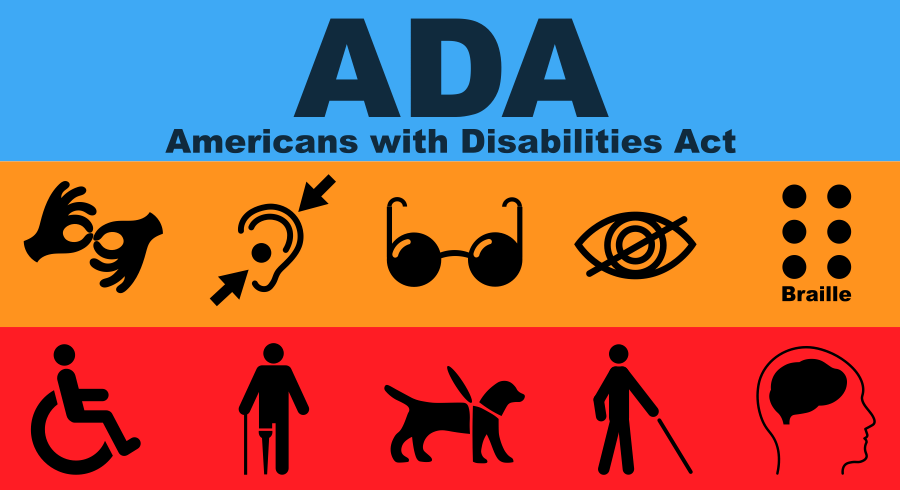
Figure 2. Infographic from the ADA.
Many of these laws were enacted fairly recently. We still have a long way to go in educating people and changing things within our communities.
ADA Overview
- Title I – Employment
- Title II – State and local governments
- Title III – Public accommodations
- Title IV – Telecommunications
- Title V - Miscellaneous
Quiz question number 1: Answer = 5 Titles!
I will spend most of my time on the ADA today, but we are also going to cover everything.
There are five titles of the ADA. The first one is employment. Titles II and III are very similar, and we will go over them together. Anything that gets even $1 of state or federal money is Title II, and anything private like private schools and movie theaters is Title III. Telecommunications is Title IV, and then miscellaneous is Title V.
Grandfather Clause?
- Although the facility may be "grandfathered" in according to the local building code, the ADA does not have a provision to "grandfather" a facility. While a local building authority may not require any modifications to bring a building "up to code" until a renovation or major alteration is done, the ADA requires that a place of public accommodation remove barriers that are readily achievable even when no alterations or renovations are planned.
- Buildings are excused from being fully compliant until they undergo renovations but must be as accessible as possible.
- THE GRANDFATHER CLAUSE DOES NOT EXIST!!!!
Quiz question 2: False!
The grandfather clause does not exist. If there is anything that you remember from today, other than the fact that I have this incredible passion for the ADA, it is the fact that the grandfather clause does not exist. The grandfather clause says that buildings do not have to be fully compliant until renovation. However, that restaurant or office building has to become as compliant as possible until that time.
Another example is a basketball arena that has no ADA seats. Perhaps they need to have a hundred ADA seats to be fully compliant, but they can get the 50 ADA seats without doing any renovations, then they legally have to do those 50 seats. Adding those 50 seats would be considered fully compliant until they renovate. The grandfather clause allows a property to be at a different level of fully compliant, but you still have to do something.
If someone says, "We are grandfathered," you can ask them, "What have you done to become as fully compliant as possible until you do your renovation?" Be sure to say it kindly.
ADA Title I: Employment
- Title I requires employers with 15 or more employees to provide qualified individuals with disabilities an equal opportunity to benefit from the full range of employment-related opportunities available to others.
- Prohibits discrimination in recruitment, hiring, promotions, training, pay, social activities
- Note: If a company has less than 14 people (ex: a restaurant with 12 employees, a private law office with 6 employees)…an employee is not protected!
Quiz question #3: 15!
Title I has to do with employment. There are a lot of laws and steps around this law. For question three, the answer is 15. For example, if you are working with a client who wants to return to work at a small law firm that only has six people and is asking for reasonable modifications, the law firm is not legally required to do so. However, as soon as they hire a 15th person, that company is not legally required to make reasonable accommodations underneath the ADA. Your first question when working with a client planning to return to work is how many people work in your office, as it will matter. Any company under 15 should still try to make their location accessible for all, but they are not legally obligated.
Title I Employment prohibits discrimination in recruiting, hiring, promotions, training, pay, and social activities.
Who is a Qualified Person?
- No employer shall discriminate against any qualified person with a disability in regard to any aspect of employment
- A person who:
- Satisfies the requisite skills, experience, education, and other job-related requirements of the position
- Can perform the essential functions of the job, with or without reasonable accommodation
Who is qualified? This goes back to occupational activities that we talked about before that meet the qualifications. The potential employee has to have the skills, experience, education, and other job-related requirements. They have to perform the job's essential functions with or without reasonable accommodations.
For example, I am strong, drive with hand controls, and have driven across the country twice. However, I could never work for UPS or Amazon Prime delivering packages as I cannot carry boxes up and downstairs. While there are many things that I can do within that job, I cannot perform some essential tasks. It would not be reasonable to say that Amazon Prime needs to get a lift on their truck as I would only be able to deliver packages to places that are wheelchair accessible.
Application Process
- Pre-employment inquiries:
- Drug and polygraph tests are acceptable if they apply to everyone
- Employer may ask if prospective employee needs reasonable accommodations in application process
- Employer must provide reasonable accommodation upon request (ex: braille application)
- No medical tests
Pre-employment inquiries are where a lot of employers get into trouble. You have to do the same thing for everybody and cannot ask about their disability even if they are in a wheelchair. They can only ask if the applicant needs help with the application process.
Interview Process
- Pre-Offer
- May ask about education, work history, and required certifications and licenses
- May not ask questions that are directly or indirectly intended to elicit information about a disability
- May ask the person to describe or to demonstrate how the essential tasks of the job would be performed if the disability is obvious or the person has disclosed a disability
If they are going to make me an offer, then during the interview, they can ask me about my education or work. They cannot ask me questions about my disability or medical history. They can ask me if I can lift a package and carry it upstairs if that is an essential job function, but they cannot ask anything about my disability.
Post Offer
- Post-Offer Employer...
- May ask disability-related questions and have medical exams if all employees entering that job classification have the same exam/inquiry, and the exam/inquiry is job-related
- May ask abouWorkers'ers’
- Compensation history
- May ask about general health history
In the post-offer, they can ask disability-related questions and ask for a medical exam if all employees have to do the same thing. For UPS or Amazon Prime, if everybody has to pass a physical or everybody has to lift a hundred-pound box up and downstairs, then they have to do that too. However, they cannot ask me to do that if they are not asking everybody to do that. They cannot discriminate against somebody because of how they look or because they show up in a wheelchair. The only question they can ask is, "Can you perform the essential functions of the job?" It is pretty straightforward.
There is a lot more information on the website, and I will be giving you a resource handout and links that review what can or cannot be asked. There is also a technical assistance site for every region in the country. I used examples of my physical disability, but you can ask questions about your specific clients.
What is a Reasonable Accommodation?
- Any change or adjustment to the job, the work environment, or the way work is customarily done which permits a qualified applicant or employee with a disability to perform the essential functions
For example, if you have a client who has diabetes and needs to check their blood sugar every hour, make sure that they get that in writing and ask for accommodation. Otherwise, your client may not be at their desk when the boss passes by every hour because they went to the bathroom to check their blood sugar.
Examples of Reasonable Accommodation"
- A "no-tech" accommodation costs little or no money...just time, support, and creativity (i.e., additional preparation time for an individual or a color-coded filing system)
- A "low-tech" accommodation is any accommodation that is technologically simple or unsophisticated and readily available in most offices (i.e., a door handle as opposed to a doorknob)
- A "high-tech" accommodation is any accommodation that uses advanced or sophisticated devices (i.e., screen reading software with synthesized speech.)
The diabetes example is a "no-tech" reasonable accommodation that does not cost anything. If Jane is not protected, she risks losing her job because she is not at her desk many times a day. A low-tech accommodation could be changing to a door handle instead of a doorknob. I have a small desk in my classroom that is lower than usual to put my laptop on when I am teaching because the typical ones are standing desks and too high. Low-tech examples could be a different chair, standing height, adjustable desk, et cetera. A high-tech solution could be reading software, text to speech software, or other types of software.
The person has to perform the essential functions and have the skills to complete the job. Above are examples of reasonable modifications to allow them to perform the job. Again, requiring a ramp or a lift to work at Amazon Prime delivery would not be reasonable for me because I still could not deliver the packages.
- May require job restructuring
- May require time off (Does not require indefinite leave and; Not required if it imposes an undue hardship on employer)
- Change in schedule
- Equipment (tape recorder, scanner, voice software, TTY)
Job restructuring may be required. They may require time off or unpaid time off for appointments, but it depends on undue hardship. Are there other people to cover your role? If you are the only one at a call center and have frequent appointments, that may not be reasonable. Another example may be an occupational therapist needing a tape recorder to help them memorize things to document later in the day.
- An office assistant needs to take a 5-minute break every 2 hours to check blood sugar.
- A professor in a wheelchair needs an overhead projector/laptop to project powerpoints because she cannot reach the board
- A doctor needs their own designated exam room with a special adjustable table
- A truck driver needs hand controls on their car.
I gave some of these examples earlier.
- Change of workplace policy (allow food at a workstation, allow service animal, allow personal items at the desk)
- Adjusting methods of supervision (communicating assignments in different ways, providing additional training, more guidance...)
- May require allowing working at home. COVID-19 has made this complicated. An employee can apply for this as a RA if they have a disability showing they need to be at home, but not if they have a family member that they need to protect/be at home for.
- Provision of a job coach
Other examples include changing a workplace policy like allowing food at a workstation, service animals, or the provision of a job coach. If you have teens or adolescents who want to work, the provision of a job coach is an example of an accommodation.
These Are NOT Accommodations
- Medication monitoring
- Lowering production standards
- Does not require the provision of personal use items (hearing aids, wheelchairs)
- Does not require a change of supervisor
- An employer cannot force an employee to accept an accommodation
These are not accommodations and are not reasonable. These are not meeting the essential job functions or the essential skill set of the job, and an employer can not force an employee to accept an accommodation. My boss cannot say, Katie, you have to use this desk in this room. And, no one can make me stand up if I prefer to sit in my wheelchair.
Asking for Reasonable Accommodations
- Does not have to be in writing, be formal, or use any special language (but documentation is best to protect the client!)
- Does not have to be requested at beginning of employment
- Case-by-case determination: Accommodation can be anything needed to allow this person with this disability to perform the essential functions of this job.
- The ADA requires that the employer and employee engage in an interactive dialogue concerning reasonable accommodations
- The employee usually initiates – the employee may inquire about the process from the supervisor, HR, or the ADA Coordinator at the agency
- The supervisor/employer does not need to know the diagnosis or particulars of the medical condition, only the limitations or restrictions on employee's ability to perform essential tasks and potential accommodations
- The employer is legally responsible to reply/provide the accommodation in a reasonable time (there is no legal time given, but 2-3 weeks is generally what is acceptable).
An accommodation does not have to be in writing legally. Still, I highly recommend it because it is crucial to make sure that you have everything documented as it is just safer. You can go right to your boss or human resources. Everything is a case-by-case determination based on what is needed. What is the environment, and what is required?
Some accommodations might be met, and some may not. It is vital to have an interactive process with a dialogue that goes back and forth between the boss or the employer, and the employee. It is trying to understand what is reasonable and come to an agreement that will work. Sometimes it is straightforward, like a shorter desk in my classroom. It is essential to talk to people as communication is important.
I am the fieldwork coordinator. We had a student who was not allowed to delay taking her notes until after treatment because they needed to have her notes done within two hours of treatment like all the other providers to see what was going on immediately. That makes sense. They also said that she could not work privately in a cube. Well, she could not get her notes done immediately because she had dyslexia, and it took a long time to do her documentation without distraction. We ended up going back and forth and came up with a reasonable accommodation. She would treat every patient, but she would do notes for every other patient. Her clinical instructor would write notes for every other patient. This solution allowed her to treat and still be in the environment.
As OTs, we need to understand what the need is from the employer and try to figure out a different solution. Don't take no the first time, but find out why.
If You Are Not Registered...
- You are NOT protected!
- Employer may discipline employee for violating a workplace conduct standard, even if the violation results from a disability
- If other Employees are held to the same standard
- Employer may have to provide reasonable accommodation to help employee to meet the standard in the future, but does not have to excuse past conduct.
If you are not registered, you are not protected. If someone with diabetes is not registered and frequently checks their blood sugar privately in the bathroom, they can be fired if management is unaware. You cannot fix this retroactively.
ADA Title II and III
- Title II – State and Local Government
- Title III – Private entities
I will talk about Title II and III together as they are very similar and overlapping; however, there are some minor differences.
Title II: What is Covered?
- All programs, services, and activities are covered (parks, museums, public schools, and universities)
- Government Services provided by Contractors
- Public Transportation
- Legislation
- Regulations
- Judicial Activities
- Everything the government entity does
- Anything that receives public funding
Title II covers public spaces like museums, park services, and even tennis courts that I use. That would be covered under title two. Anything that gets public money is covered under Title II.
Title II: Effective Communication
- Must provide auxiliary aids and services to make communication with people with disabilities as effective as communication with non-disabled people
- Examples: sign language interpreter, TTY, taped text, braille, reader, note-taker...
- Individualized standard –communication must be effective for this person in this situation
- Cannot surcharge for the cost of compliance
Effective communication is an important one. If you have ever heard a loud screen test on television, this is related to Title II. Everybody needs to understand what is going on. For example, in a town hall meeting, you have the right to a free interpreter if you are deaf without any cost. Title II also includes braille or a note-taker to assist those with communication needs. I work at the University of North Carolina, but I also work at the UNC Hospital as part of their medical school. If we have a patient who has communication deficits, we are required to provide effective communication under Title II as a state hospital.
Title II: Transportation
- The Americans with Disabilities Act (ADA) requires public transit agencies that provide fixed-route service to provide complementary paratransit service to people with disabilities who cannot use the fixed-route bus or rail service because of a disability.
- Every public transportation system has to offer paratransit.
Title II also provides transportation laws for people with disabilities. The Americans with Disabilities Act requires that any public transportation system provide equal service to people with disabilities, usually in the form of complementary paratransit services. Paratransit service is a fixed, shared-ride system where they go door to door or curb to curb and pick up people with disabilities and take them to their destination. It is not linear as there can be multiple people and destinations. Paratransit can charge no more than twice the price of another transport method like a bus. So if the bus is $2, paratransit cannot be more than $4. It is a fantastic service, especially for people who can no longer drive. I used to work in a paratransit company in Santa Clara County in California. We transported many older people with visual impairments and physical disabilities. This service is not just for doctors' appointments. We would take them anywhere, like the movies, friends' houses, and anywhere within the county. Services usually overlap amongst counties. For example, a person can go from one county, meet at a mall, and then the other county would pick them up. It is a fantastic service. I highly recommend you look up paratransit services for your county because it will be life-changing for your clients.
Title II: Programs, Services, and Activities
- Must be accessible when viewed in their entirety
- Does not necessarily require each facility to be accessible
- May use alternate means to make programs accessible
- Examples: curb service, home service, move meetings to accessible space on request
Title II also covers programs, services, and activities. It does not mean that everything has to be accessible, but when things are not physically accessible, they may have to use alternative means to allow everyone access.
Title III Includes:
- Restaurants
- Hotels
- Movie theaters,
- Private schooDoctors'ors' offices, clinics, and hospitals (unless state-funded, then Title II)
- Gyms...
- Places where occupations happen!!!
Title III covers restaurants, hotels, movie theaters, and anything private. UNC-Chapel Hill is public, but Duke, down the road, is private, so that they would be under Title III. A restaurant would not need to have something in braille, but they may need to have a waitress or waiter read the menu to them or provide other accommodations in that regard.
Talking about accessibility, under Titles II and III, all the standards are the same. For example, the bathroom widths are all the same.
Title III: Public Accommodation
- Must comply with basic nondiscrimination requirements that prohibit exclusion, segregation, and unequal treatment.
- Must comply with specific requirements related to architectural standards for new and altered buildings;
- Reasonable modifications to policies, practices, and procedures;
- Effective communication with people with hearing, vision, or speech disabilities; and other access requirements.
- Public accommodations must remove barriers in existing buildings where it is easy to do so without much difficulty or expense, given the public accommodation's resources.
Accessibility Title II and III
- Signs/Entrances
- Bathrooms
- Parking
Under Title II and III, signs/entrances, bathrooms, and parking are covered.
- Signs/Entrances
- Regulations passed in 1990 with the Americans with Disabilities Act require all businesses to have ADA-compliant wayfinding signs!
- Next time you enter a building, and there is not an accessible entrance in the front, check to see if there is a sign indicating where the accessible entrance is. If there is no sign, it is an ADA violation…please let someone know.
- For more info, It is ADA standard 216.6
One of the most significant issues, especially here on the East coast, is that if a building does not have a physically accessible entrance, no sign indicates where the accessible entrance is. Here in Chapel Hill, I will get to the front of the building that is not accessible, and then I have to decide if I should go left or right. Remember, the name is titled as such for a reason. If I choose wrong, I go downhill and then come back uphill to get to the right side. This happens all the time and not just on campus but everywhere. The ADA requires an entrance sign indicating where the accessible entrance is, as seen in Figure 3.
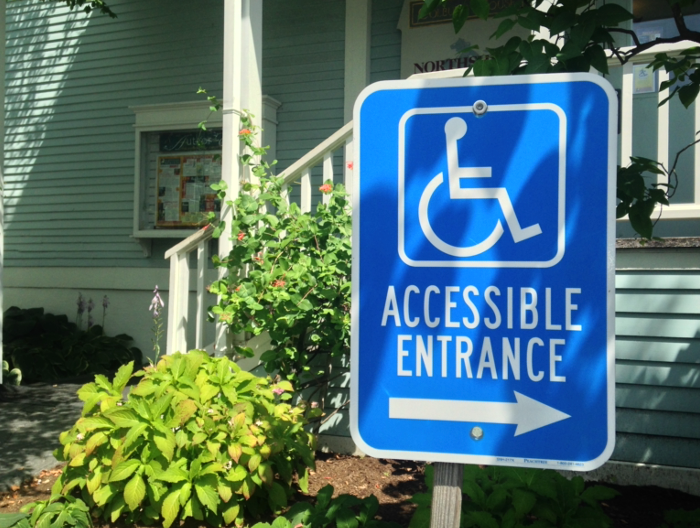
Figure 3. Example of an accessible entrance sign.
I hope that you start looking for this in your community. Again, if there is no ramp or an accessible entrance, that is okay. However, they need a sign. If you do not see a sign, say something. For more information on ADA standard signs, you can look up the ADA standard, 216.6, for more details on that.
- Doors/Entrances
- Doors
- ADA Chapter 4 Standard 404
- Weight limits for interior doors
- Door width is 32"
- Doors
I have all the standards on here that you guys can look up later, but I just wanted to give you a general overview. This is from ADA chapter four, standard 404 (Figure 4).
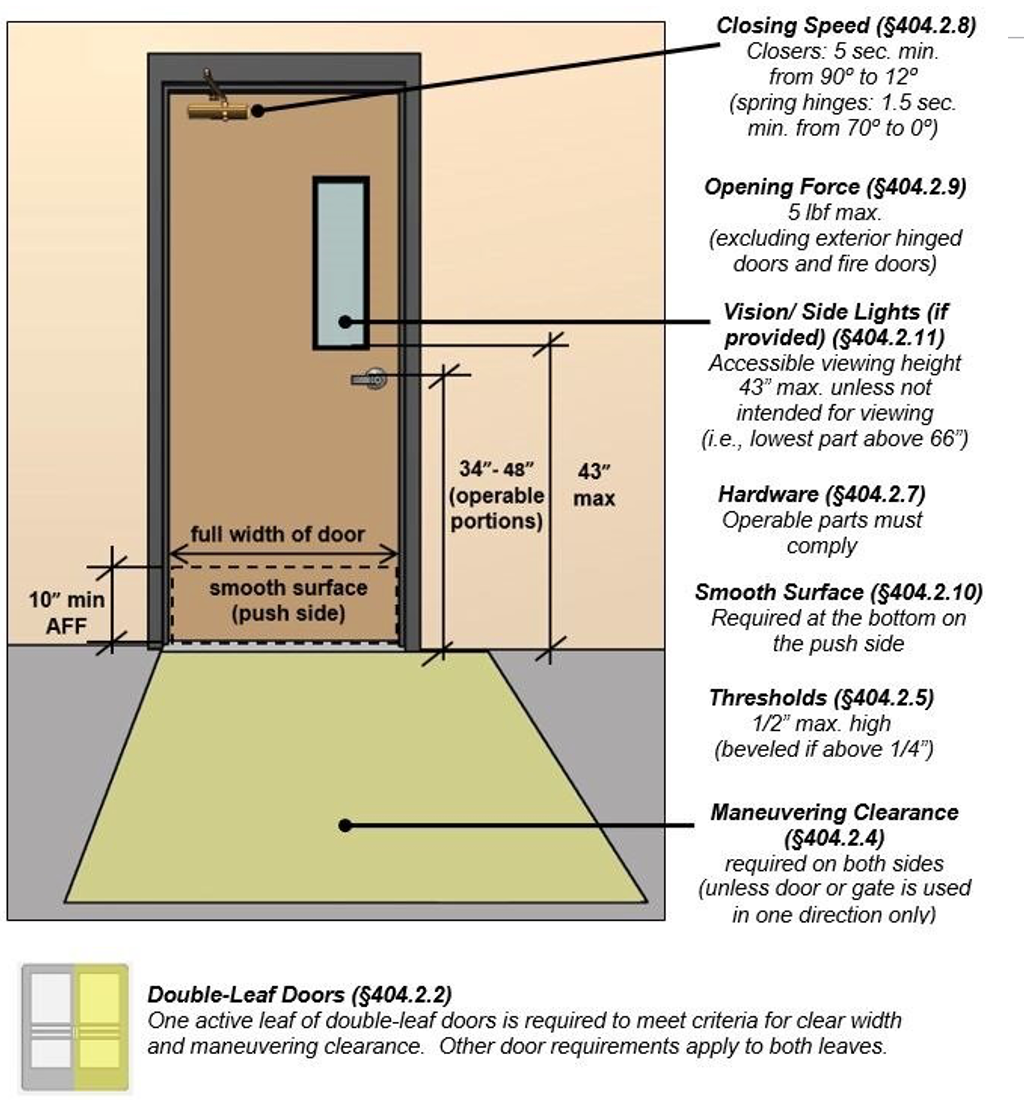
Figure 4. Example of door dimensions (Source: https://www.access-board.gov/ada/guides/chapter-4-entrances-doors-and-gates/).
There are weight limits for interior doors. You can have no more than five pounds for interior doors, but the exterior doors do not have this criterion because they can be fire, windproof, or load-bearing. Exterior doors can be heavy. Interior doors' spring hinges can be adjusted. There are some YouTube videos on how to make this adjustment. Get a wrench and adjust it to be within five pounds. The door should be 32 inches wide, and the handle should be 34 inches high. An accessible handle would be a lever, not a knob.
Closing speed is another factor as it can be hard to get through a door that is closing fast. The closing speed and weight can be changed and adjusted reasonably quickly and cheaply. You also have to have a specific maneuvering clearance, especially outside.
- Doors/Entrances
- Ramps
- 1 inch up needs 1 foot of ramp!
- Average curb is 6" high, which would require a 6' ramp
- ADA Standard 405 and 406
- Ramps
This is a question I get asked all the time. What is a standard ramp slope to height ratio? It is one foot of ramp for every one inch of height. So, a 12-inch rise would require a 12-foot ramp. You can get away with one inch of rise to 10 inches of run, but 1:12 is ideal. You also need to have guardrails if the ramp is a certain height. There is also a cross slope perfect, one to 48, but you do not need to memorize all of this as the one inch to one foot is the most crucial part. The average curb height is six inches high, requiring a six-foot ramp for ADA compliance. These are the general standards of ramps, and that is standard 405, as seen in Figure 5. You can look up these and standards 405 and 406 for more information on ramps.
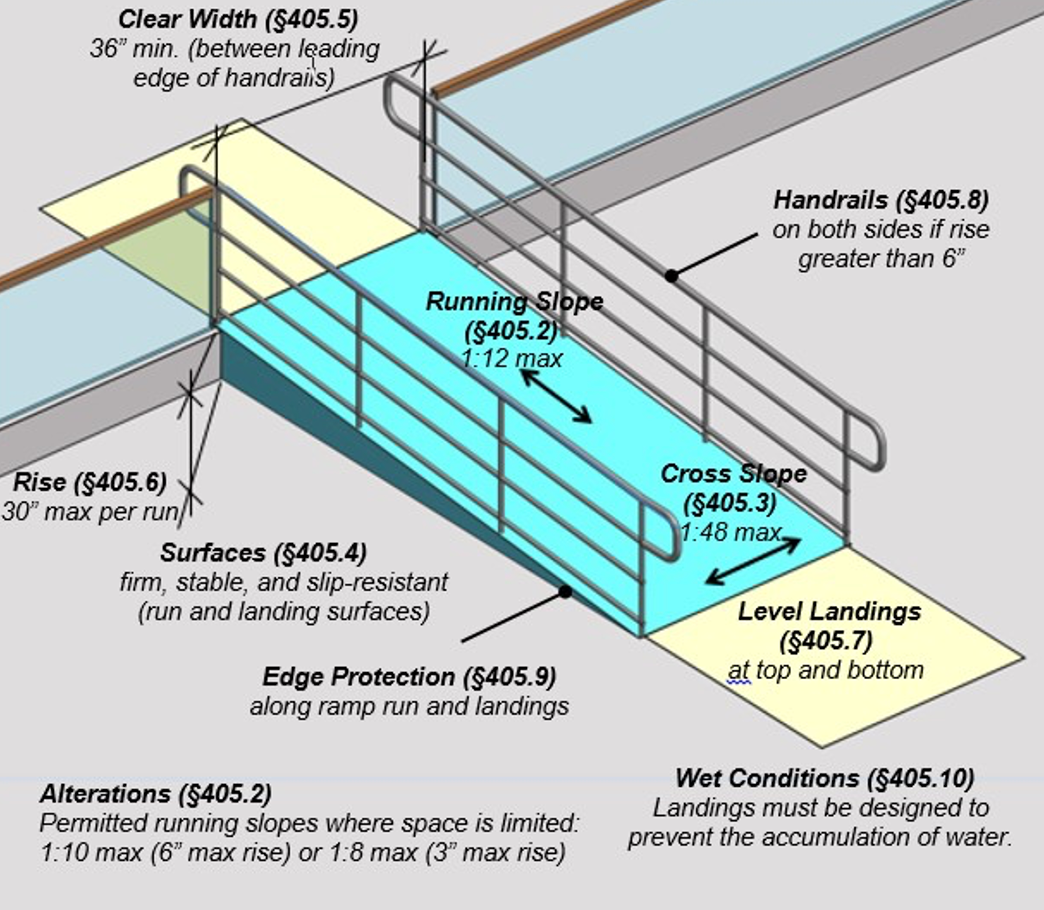
Figure 5. Example of ramp specifications (Source: https://www.access-board.gov/ada/guides/chapter-4-ramps-and-curb-ramps/).
Often, you will come across things that are not compliant, as shown in Figure 6.
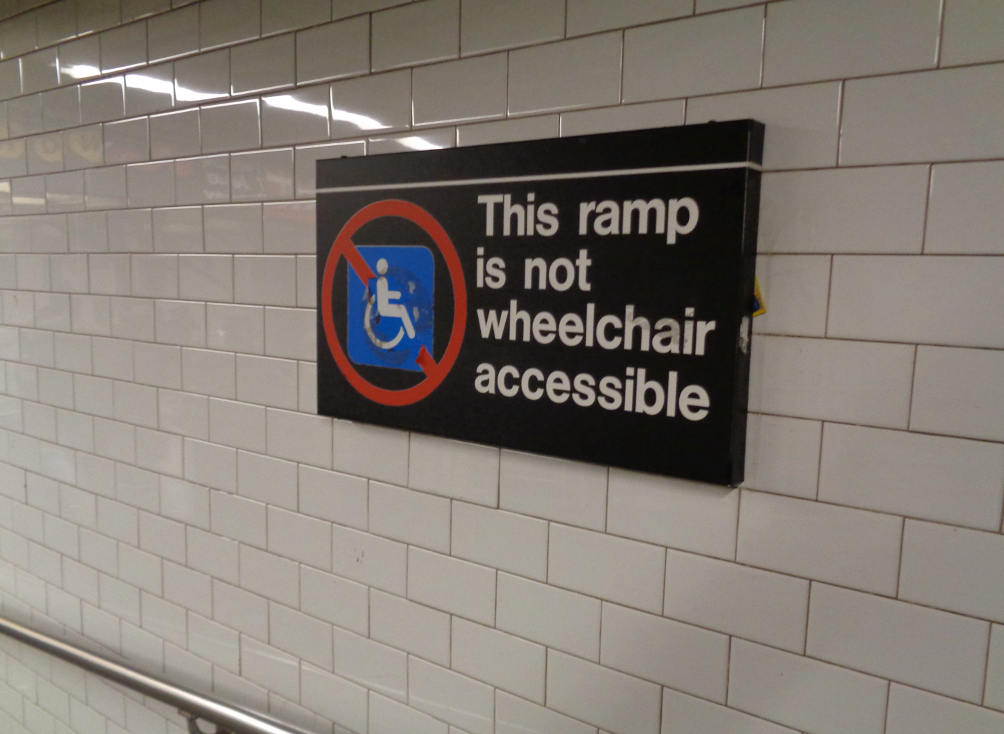
Figure 6. Example of a non-compliant sign.
Your clinics may not be compliant. Do you have a counter that is 36 inches in height, doors that are light enough, accessible parking, or a curb cut ramp? I encourage you to check your clinic and parking lot and see if changes need to be made.
- Bathrooms
- ADA Checklist: https://adachecklist.org/doc/priority3/p3.pdf
Bathrooms are another big area to check for ADA compliance. Figure 7 shows an example of a bathroom that is ADA compliant.
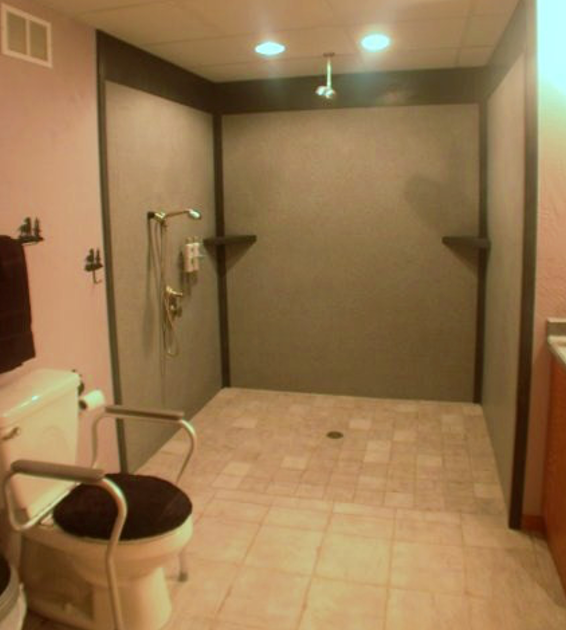
Figure 7. Example of an ADA compliant bathroom.
I have also included an ADA checklist that is standard 603 and 213. Figure 8 shows some of the specifics.
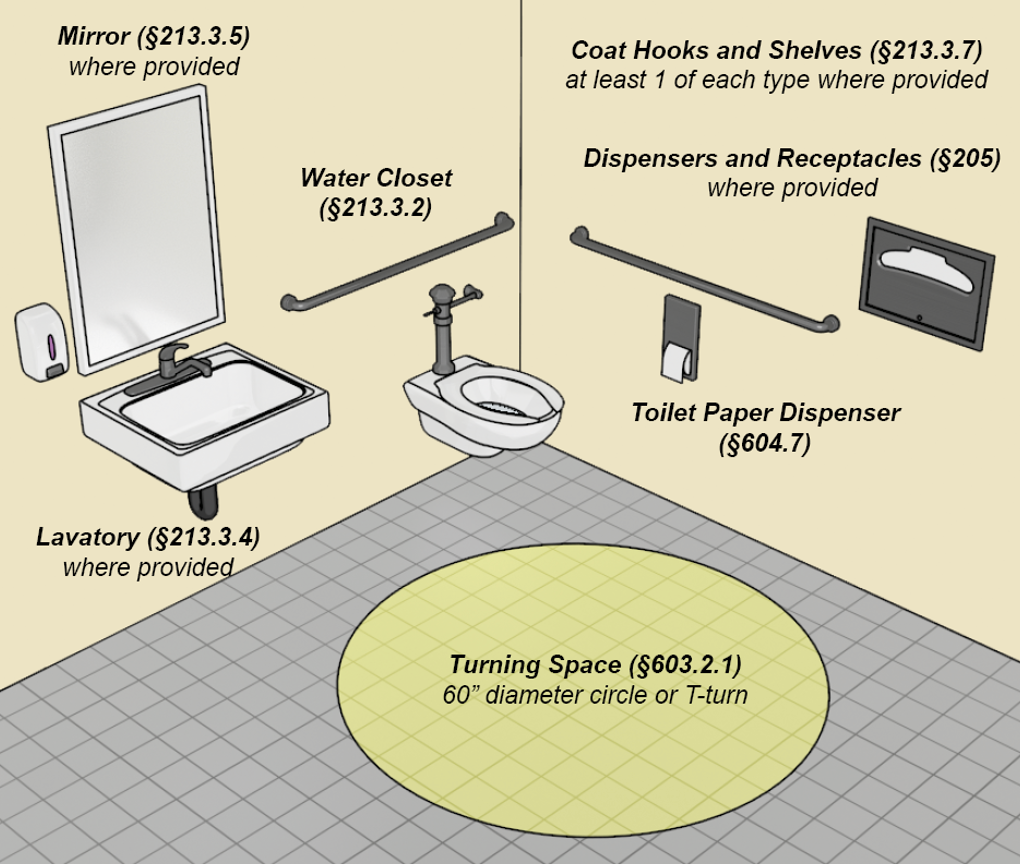
Figure 8. Bathroom specifics (Source: https://www.access-board.gov/ada/guides/chapter-6-toilet-roomhttps://adachecklist.org/doc/priority3/p3.pdfs/).
There should be handles on the back and side of the toilet, and the height is usually 17 and 19 inches. The toilet dispenser also has to be a certain height. The pipes under the sink have to be protected, especially for people with sensory issues (Figure 9).

Figure 9. Example of covered pipes for safety on the bottom.
The biggest issue I encounter in the bathroom is the stall door. Many times the door swings into the stall, and then I cannot get in and close the door behind me. I carry wrenches around change the door lever around to make it compliant. My friends worry that I will get in trouble, but I think they should give me a free dessert since I made their bathroom compliant.
- ADA Checklist for Existing Facilities- Priority 3- Toilet Rooms
- 3.17 Is there clear floor space available for a person in a wheelchair to turn around, i.e., a circle at least 60 inches in diameter or a T-shaped space within a 60-inch square? [603.2.1]
- 3.18 In a single-user toilet room if the door swings in and over clear floor space at least 30 x 48 inches beyond the swing of the door? [603.2.3 Exception 2]
- 3.19 If the mirror is over a lavatory or countertop, is the bottom edge of the reflecting surface no higher than 40 inches above the floor?
Or
- If the mirror is not over the lavatory or countertop, is the bottom edge of the reflecting surface no higher than 35 inches above the floor? [603.3]
Source: https://adachecklist.org/doc/priority3/p3.pdf
In the ADA checklist for bathrooms, you will find some of the areas we already discussed, like the doors swinging in, not having the sink pipes covered (so that people who have a spinal cord injury or other sensory impairments are not getting burned), and correct grab bars around the toilet. Once you go over this, you will start to see things that need to be corrected.
- Another checklist is for entrances, parking goods, and services. I encourage you to check these out.
- 1.1 Is there at least one route from site arrival points (parking, passenger loading zones, public sidewalks, and public transportation stops) that does not require the use of stairs? (See 2010 ADA Standards for Accessible Design- 206.2.1)
- Parking- Accessible parking spaces should be identified by size, access aisle, and signage.
- 1.2 If parking is provided for the public, are an adequate number of accessible spaces provided? [208.2]
- 1.3 Of the accessible spaces, is at least one van accessible space? [208.2.4]
- 1.8 Is the slope of the accessible parking spaces and access aisles no steeper than 1:48 in all directions?[502.4]
- 1.9 Do the access aisles adjoin an accessible route? [502.4]
- 1.10 Are accessible spaces identified with a sign that includes the International Symbol of Accessibility?
- Is the bottom of the sign at least 60 inches above the ground? [502.6]
- Note: The International Symbol of Accessibility is not required on the ground
Source: https://www.adachecklist.org/doc/fullchecklist/ada-checklist.pdf
- Access to Goods and Services
- Does your clinic have a lower check-in counter?
- Sales & Service Counters- banks, stores, dry cleaners, auto repair shops, fitness clubs, etc.
- 2.76 Is there a portion of at least one of each type of counter that is:
- No higher than 36 inches above the floor?
- At least 36 inches long? [904.4.1]
- Sales & Service Counters- banks, stores, dry cleaners, auto repair shops, fitness clubs, etc.
- Does your clinic have a lower check-in counter?
When you go back to your clinic, do you see a lower counter that is 36 inches high? Is there a card reader that people can reach? When I go to the post office, I have to have somebody put my credit card into the card reader because I cannot reach it, which is annoying and embarrassing.
Title II & III Effective Communication
- The purpose of the effective communication rules is to ensure that the person with a vision, hearing, or speech disability can communicate with, receive information from, and convey information to, the covered entity.
- Covered entities must provide auxiliary aids and services when needed to communicate effectively with people who have communication disabilities.
- Ex: Entity (public or private) must provide effective forms of communication when requested (ex: town hall must provide an interpreter for meetings, Movie theater must provide listening devices, a waiter reading the menu to a person who is blind, pointing to product information or writing notes back and forth to answer simple questions about a product may allow a person who is deaf to decide whether to purchase the product, etc.).
- A family member cannot be considered an interpreter if one is requested
- It is illegal to charge clients to pay for the accommodation!
If someone has a communication impairment, what does that look like? You cannot make the person provide their communication source like a family member. You have to provide a different source if they want them, and it is illegal to charge them to pay for their accommodation. In a clinic or hospital, you have to provide that accommodation for them.
Other Important Disability Rights
Fair Housing Act
- Both privately owned and publicly assisted housing, regardless of whether they are rental or for-sale units, must meet the accessibility requirements of the Fair Housing Act when they are located in a building of four or more units, built for first occupancy after March 13, 1991. This applies to property overseen by property management companies.
- It is unlawful for any person to refuse to make reasonable accommodations in rules, policies, practices, or services when such accommodations may be necessary to afford a person with a disability equal opportunity to use and enjoy the dwelling.
- Reasonable Modifications
- Front-loading washer dryer
- Stove with knobs on the front
- Adding grab bars
- Lowering closet racks/cabinets?
- Reserved parking spot even when spots are not reserved for other residents
- Charging upper unit price to a lower unit when the upper unit is not accessible
Some reasonable modifications include a front-loading washer and dryer, a stove with knobs on the front, grab bars, and low closet racks or cabinets. An example of a stove with front controls is in Figure 10.

Figure 10. Stove with knobs on the front.
For parking, the answer to question five is false. If parking spots are not reserved for other residents, it is still reasonable for your client to have their own reserved parking spot in front of their apartment to a mobility issue or wheelchair use. It is typically a lot cheaper to rent on a third floor than on the first floor. But if the third floor is not accessible, you have to offer the accessible unit on the first floor at the same price.
We have a question related to rental units. "I have a patient living in low-income housing, but his apartment complex is telling him they do not have to accommodate him by constructing a wheelchair ramp for him or adapting his bathroom in any way. Is this legal?" The Fair Housing Act only applies if there are four or more dwelling units. If there are only three units where he lives, they do not have to do anything. If there are four more units or renting under a property management company that is overseeing more than four units, then that unit does have to do something. The only other time that this company or the low-income housing could say that they do not have to do anything is if it would be a financial hardship for the housing unit to provide that accommodation. As an example, the housing unit would have to explain why adding a ramp or adapting the bathroom would be a hardship. If they can provide proof, then they are off the hook. However, for something simple like grab bars, they cost approximately $40. I had a contractor come in, find the studs, and install some grab bars in the bathroom. This was not hard or a substantial financial obligation. If the building owner is not willing to do that, then I recommend that you talk to the city or the regional ADA office. Another suggestion is a standing grab bar on Amazon that does not require renovation. They are about like $130 to $150.
Figure 10 is my kitchen. This summer, I bought my first house and had a contractor friend lower the cabinets. As I am my own landlord, I was able to do that.
Air Carrier Access Act
- Applies to:
- All domestic (US) flights, regardless of carrier
- All flights that take off from the US and go internationally (both ends of the flight are protected)
- All flights that take off internationally and are coming to the US (both ends of the flight are protected)
- All flights, even if both departure and destination are international locations, on carriers that are US-based (ex: American Airlines, United, Delta).
The Air Carrier Access Act requires that all domestic flights, regardless of carrier, meet the federal laws of the Air Carrier Access Act.
- Carriers shall provide assistance...in enplaning and deplaning. The delivering carrier shall be responsible for assistance in making flight connections and transportation between gates. §382.39 (a)
- This assistance shall include...the services personnel and the use of ground wheelchairs, onboard wheelchairs...and ramps or mechanical lifts. §382.39 (a) (1)
This involves all transportation including from the curb to the front door of the plane, loading onto the plane, storing their luggage early, getting them off the plane, embarking, and then getting them to the baggage claim with their luggage, and then to their transportation. It is helping them the entire way. Figure 11 shows an aisle chair that can help somebody get on and off a plane.
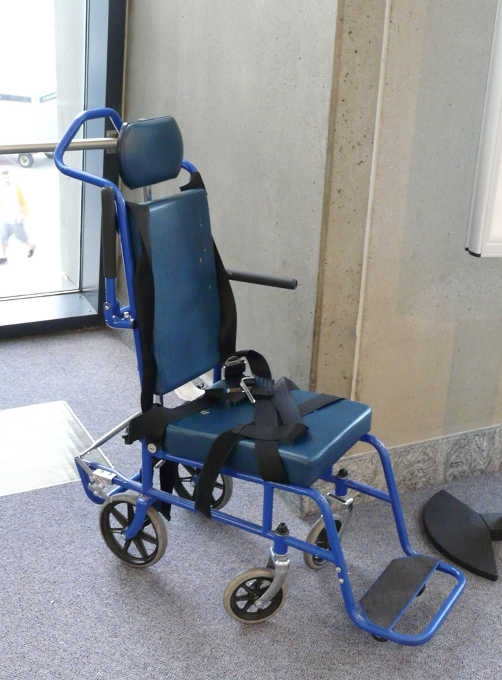
Figure 11. Aisle transport chair.
One of the most significant issues with transportation on a plane is the bathrooms. Planes only have an ADA bathroom if they have two aisles on the plane, but most domestic planes only have one aisle. We recommend that men carry an empty soda bottle. Women are not able to do that. I just do not drink most of the day. I can use my crutches to walk short distances, so I try to get a seat as close to the bathroom as possible. When I cannot access the bathroom, I try not to drink most of the day, which is a bummer.
The other issue is that airlines can damage mobility devices, especially power wheelchairs. The Air Carrier Access Act protects travel for people with disabilities for all domestic flights. It also protects people with disabilities for any flights that take off from the US and vice versa regardless of carrier. If you start in Paris flying Air France and go to the US, you are protected, and if you start in the US and on Air France and go to Paris, you are protected, or any US-based flights. So if you have clients who like to travel, I encourage you to tell them to travel on US-based carriers like United, Delta, or American Airlines because you know that they will have access to laws that they may not have on other airlines.
- According to §382.125(c), airlines must allow for the checking and timely return of wheelchairs at the boarding gate...THE DOOR OF THE PLANE!!!!
- Carriers must offer preboarding to passengers with disabilities who self-identify at the gate as needing additional time to board. In a March 2013 notice to airlines, carriers were advised by the DOT that preboarding means before all other passengers, including first-class passengers, elite-level passengers, members of the military, passengers with small children,"." §382.93
- Carriers shall not leave a passenger with a disability unattended in a ground wheelchair, boarding wheelchair, or other device, in which the passenger is not independently mobile, for more than 30 minutes. §382.39 (a) (3)
One of the biggest issues that I have during travel is not having my wheelchair given to me at the plane's door when I land, which is a federal right. When I flew to Paris two years ago, I got off the flight in JFK from Paris, and the grounds crew would not bring my wheelchair to me. They said it had to go through customs. According to section 382.125c, the airline is required to bring my wheelchair to the door of the plane in a timely manner. The Norwegian Air flight crew, including the pilots, waited at the gate until the grounds crew brought me my wheelchair because they all knew it was a federal law. Here is the crew in Figure 12.

Figure 12. The crew from Norwegian Air.
I had a right to my wheelchair and did not want to get in an airport transport chair because it was unsafe. My feet do not reach the ground.
I encourage you to educate your clients on these laws. They can take screenshots on their phone or print up the law. Having that knowledge is power and allows our clients to engage in occupation in the community safely.
For More Technical Assistance
- https://adata.org/find-your-region
You can find your region at adata.org. There should be an ADA coordinator who can answer technical questions.
Summary
- It is important to empower your clients with their rights as they engage in meaningful occupations in your community.
- And OTs are uniquely equipped to advocate for and promote accessibility compliance. There is no overriding entity enforcing compliance...what can you do?
- Be familiar enough with the laws that you can look them up.
- If you are out and see something not compliant...say something and kindly educate the owner of the entity. A lot of people do not know the laws or are misinformed #grandfatherclause
- Empower your clients and their families to learn the laws!
Thank you all so much for your time, as I am passionate about this topic. All of us need to empower our clients about the laws. Tammy Duckworth, a senator from Illinois, says, "We're all one bad day away from needing the ADA." At some point, we will all have some sort of limitation, even if it is temporary. It is essential to know the laws and advocate for clients, family, and even yourself. Look at bathrooms, entrances, ramps, etc., as the little things make a huge difference.
Resources
- https://www.ada.gov/reachingout/factor.html
- https://www.eeoc.gov/eeoc/publications/fs-ada.cfm
- https://www.huduser.gov/portal/publications/pdf/fairhousing/fairintro.pdf
- https://ifhcidaho.org/resources/guide-to-reasonable-accommodation-in-housing-under-the-fair-housing-act/
- https://www.huduser.gov/portal/publications/destech/fairhousing.html
- https://nwadacenter.org/toolkit/fair-housing-act-accessibility-resources
- https://www.adachecklist.org/doc/fullchecklist/ada-checklist.pdf
- https://www.access-board.gov/the-board/laws/architectural-barriers-act-aba
- https://wheelchairtravel.org/air-travel/air-carrier-access-act-summary/
- https://odr.dc.gov/sites/default/files/dc/sites/odr/publication/attachments/ada_trng_masters_0.pdf
- https://adachecklist.org/doc/priority3/p3.pdf
- https://www.adasoutheast.org
Questions and Answers
I love that the whole Norwegian fight crew waited there with you. That is a great picture.
I am Facebook friends with half of them now. We talked on the jetway at JFK for 45 minutes. They would not let the next flight crew load until they came for my wheelchair. I was pretty stoked.
My husband recently had a retinal tear and has lost peripheral vision in his left eye. He is hoping that this will improve but is unable to drive. What would you recommend for us to do? He also has difficulty without stumbling. Should we be working on a handicap sticker?
I am unsure where you live, but I recommend getting paratransit services. I do not know what that would look like in your community, but there may be travel training for your community's bus and transportation system. Paratransit is a fantastic service that so many people are unaware that it is federally funded. I would also talk to his doctor about getting a handicap sticker, especially if it is unsafe.
One of the biggest reasons I use a wheelchair-accessible parking spot is that I need the extra space to get out of my van. It is also really unsafe for me to propel a wheelchair behind parked cars because they cannot see me. If your husband is stumbling and tripping, it may be dangerous for him, especially if the pavement has potholes, ice, or any other barriers. Depending on his mobility, he may benefit from a mobility device.
Citation
Sorensen, K. (2022). Reasonable modifications: What does the ADA say? And what are the rights of your clients? OccupationalTherapy.com, Article 5489. Available at www.occupationaltherapy.com
